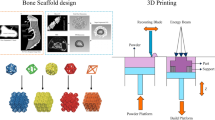Abstract
In this paper, biologic properties and physical properties of the bioscaffold are studied. The requirements of the model of defective bone repair bioscaffold are proposed. Then, a new modeling method is presented, which can construct a defective bone repair bioscaffold 3d digital model that has the macro-shape and macro-pores. This method combines the image processing technology, 3d-reconstructing technology, and a new hole filling method, in which a mapping method is developed. It can be used in both symmetrical and unsymmetrical defective bone. By programming, this method was successfully implemented and the repair bioscaffold 3d digital model was constructed. Through RP process, using polymeric blends, the physical model was obtained, which meets the requirements of the bioscaffold.
Preview
Unable to display preview. Download preview PDF.
Similar content being viewed by others
References
Chuanglong, H., Yuanliang, W., Lihua, Y., Jun, Z., Liewen, X.: Recent Advances in Natural Derived Extracellular Matrix Materials in Bone Tissue Engineering. Chinese Biotechnology 23(8), 11–17 (2003)
Liu, H., Hu, Q., Li, L., Fang, M.: A Study of the Method of Reconstructing the Bionic Scaffold for Repairing Defective Bone Based on Tissue Engineering. IFIP 207, 650–657 (2006)
Ho, S.T., Hutmacher, D.W.: A comparison of micro CT with other techniques used in the characterization of scaffolds. Biomaterials 27, 1362–1376 (2006)
Deville, S., Saiz, E., Tomsia, A.P.: Freeze casting of hydroxyapatite scaffolds for bone tissue engineering. Biomaterials 27, 5480–5489 (2006)
Qingxi, H., Xianxu, H., Liulan, L., Minglun, F.: Design and Fabrication of Manual Bone Scaffolds via Rapid Prototyping. ITIC 1, 280–283 (2006)
Lorensen, W.E.: Marching Cubes: A High Resolution 3D Surface Construction Algorithm. Computer Graphics 21(4), 163–169 (1987)
Delibasis, K.S., Matsopoulos, G.K., Mouravliansky, N.A., Nikita, K.S.: A novel and efficient implementation of the marching cubes algorithm. Computerized Medical Imaging and Graphics 25, 343–352 (2001)
Melax, S.: A Simple, Fast, and Effective Polygon Reduction Algorithm, Game Developer Magazine (November 1998), http://www.melax.com
Shi-xiang, J., Jian-xin, Y.: Model Simplification Algorithm Based on Weighed Normal Changes. Journal of system simulation 17(9) (September 2005)
Liepa, P.: Filling holes in meshes. In: Proceedings of the 2003 eurographics/ACM SIGGRAPH symposium on geometry processing (SGP 2003), pp. 200–205 (2003)
Xueliang, P., Laishui, Z., Shenglan, L.: Triangle Mesh Smoothing Method with Feature Preservation. Computer engineering and application 12 (2006)
Shewchuk, J.R.: Triangle: Engineering a 2D Quality Mesh Generator and Delaunay Triangulator, http://www.cs.cmu.edu/~quake/tripaper/triangle0.html
Guangming, L., Jie, T., Huiguang, H., Mingchang, Z.: A Mesh Smoothing Algorithm Based on Distance Equalization. Journal of Computer-Aided Design & Computer Graphics 14(9) (September 2002)
Taubin, G.: A signal processing approach to fair surface design. In: ACM, Proceedings of the 22nd annual conference on Computer graphics and interactive techniques (September 1995)
Author information
Authors and Affiliations
Editor information
Rights and permissions
Copyright information
© 2007 Springer-Verlag Berlin Heidelberg
About this paper
Cite this paper
Hu, Q., Yang, H., Yao, Y. (2007). A Software Method to Model and Fabricate the Defective Bone Repair Bioscaffold Using in Tissue Engineering. In: Li, K., Li, X., Irwin, G.W., He, G. (eds) Life System Modeling and Simulation. LSMS 2007. Lecture Notes in Computer Science(), vol 4689. Springer, Berlin, Heidelberg. https://doi.org/10.1007/978-3-540-74771-0_51
Download citation
DOI: https://doi.org/10.1007/978-3-540-74771-0_51
Publisher Name: Springer, Berlin, Heidelberg
Print ISBN: 978-3-540-74770-3
Online ISBN: 978-3-540-74771-0
eBook Packages: Computer ScienceComputer Science (R0)




